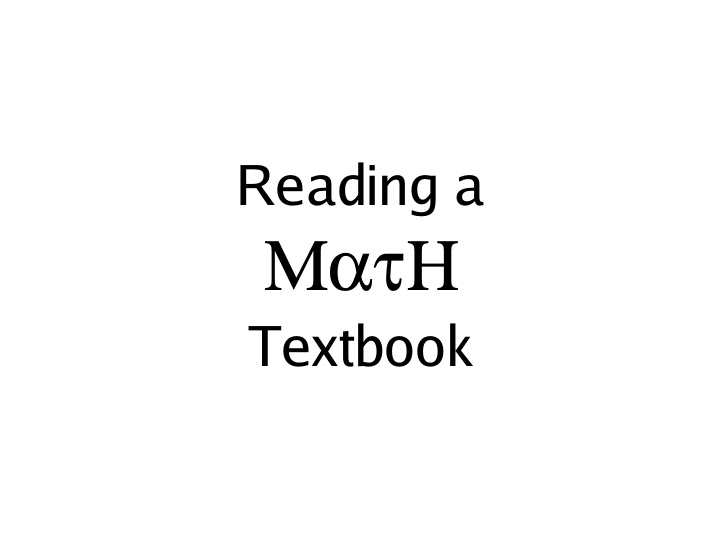



Reading a ΜατΗ Textbook
Words describing Math Textbooks scary condensed difficult incomprehensible
Example Start reading Looks like class No big deal
Example man I hate limits. equals equals equals equals long word! should I be paying attention?
Example Some problems. Looks like I could do them. Yup, those answers look correct, skim... skim...
Example Homework. Tomorrow! What were the problems again? Oh, look at my email & that fun webpage. Right, hwk.
Ummm..... Example Delta y over Delta x I have an equation x changing I don't understand Maybe I should skip this one...
What happened? ● Reading for speed. ● ● Not focused – background activities – not prepared => distractions.
What to do? ● Read for comprehension. – Different speeds. ● General idea: skim – Circle unfamiliar words. ● Detail: read slowly and reread. – Mathematicians hate fluff.
What to do? ● Read for comprehension. – Multiple times! ● Skim once before class ● Difficult sentences: 2-5 times ● Even, read aloud.
What to do? ● Simple examples measure comprehension – Read example SLOWLY – Fill in missing steps. – Mark in margin concept learned.
Math books are not novels ● For best results: – Read in quiet surroundings. – Have a designated “reading time”. – Have everything ready before starting. ● Make notes in your book. – More information is better. – Post-its? Highlighters?
Highlighters gone wild! R A I N B O W
Notes serve purposes. ● Itch to highlight? Write either: ● What it does. – Introduces an important idea. – Explains how to apply important idea. – Important technique to remember ● What it says. – Definition of ∆ y / ∆ x – Example using ∆ y / ∆ x ● Something that doesn't make sense!
Now, let's redo the example correctly
Example Read slowly! If it looks like class and is confusing, Look at your notes.
TIPS Reading: when something is not clear reread it slowly parse it step by step. class notes may help. Worked Problems: Cover up solutions and do on own. Write down important concepts. Homework: Cover up answers and try multiple approaches. Do NOT work backwards.
References: Engaging Ideas: The Professor's Guide to Integrating Writing, Critical Thinking, and Active Learning in the Classroom Chapter 8: Helping Students Read Difficult Texts Two websites on how to read a math textbook: http://wc.pima.edu/~carem/Mathtext.html http://academic.cuesta.edu/acasupp/AS/704.htm
Recommend
More recommend